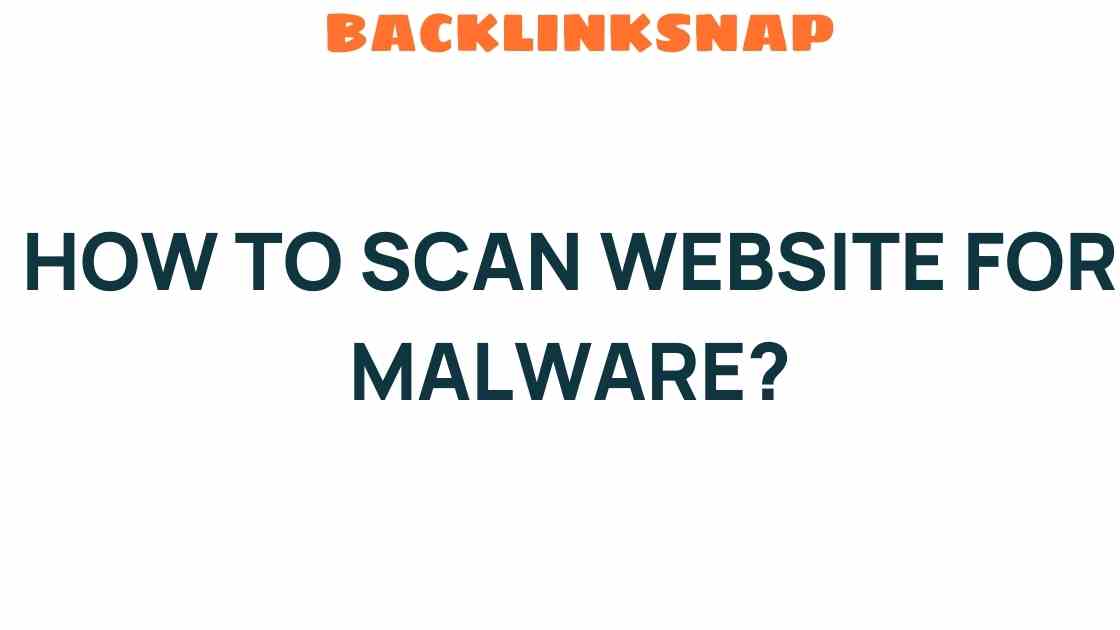How to Scan a Website for Malware: Protect Your Online Presence
In today’s digital age, maintaining a secure online presence is more vital than ever. With cyber threats looming at every corner, understanding how to scan a website for malware has become a crucial skill for individuals and businesses alike. Malware can disrupt website functionality, steal sensitive information, and tarnish your reputation. In this article, we will delve into effective strategies to safeguard your website, exploring various cybersecurity tools and malware scanners that can help you ensure your website integrity and overall online safety.
Understanding Malware and Its Implications
Before we jump into the scanning process, let’s clarify what malware is. Malware, or malicious software, refers to a variety of software designed to harm, exploit, or otherwise compromise the integrity of your system and data. It includes viruses, worms, trojan horses, ransomware, and spyware. Each type of malware has its unique method of attack, but all share the common goal of causing damage or stealing information.
The implications of a malware infection can be severe. For businesses, it can mean data breaches, financial loss, and a significant decline in customer trust. Individuals may face identity theft and loss of personal data. Therefore, scanning your website regularly for malware is not just a good practice; it’s essential for protecting your digital assets.
Why You Should Scan Your Website for Malware
Scanning your website for malware serves several crucial purposes:
- Early Detection: Regular scans can help detect malware before it causes significant damage.
- Website Integrity: Ensures your site remains functional and trustworthy for visitors.
- SEO Benefits: Google and other search engines penalize websites with malware, affecting your search rankings.
- Customer Trust: Maintaining a secure site fosters trust among your users.
How to Scan a Website for Malware
Now that we understand the importance of malware detection, let’s explore the steps you can take to scan a website for malware effectively.
1. Use Online Malware Scanners
One of the easiest ways to start your malware scanning process is by utilizing online tools. There are several reputable malware scanners that allow you to check your website for vulnerabilities:
- Sucuri SiteCheck: This tool scans your website for malware and provides a detailed report.
- URLVoid: It checks your site’s reputation and identifies potential threats.
- VirusTotal: This service allows you to upload files or enter URLs to check for malware.
2. Leverage Security Plugins
If you’re using a content management system (CMS) like WordPress, consider installing a security plugin. Many plugins come with built-in malware scanning capabilities:
- Wordfence: Offers comprehensive security features, including a malware scanner that checks for vulnerabilities.
- MalCare: Provides an automatic malware scanner and real-time protection.
- iThemes Security: This plugin includes options for malware scanning and security hardening.
3. Manual Scanning
While automated tools are invaluable, manual checks can also be beneficial. Here’s how you can do it:
- Check your website’s files and directories for any unfamiliar or suspicious files.
- Monitor your website’s performance; slow load times can indicate malware infection.
- Review your website’s code for any unauthorized changes.
4. Regular Backups
Though not a scanning method, maintaining regular backups is a vital part of your digital protection strategy. In the event that your website does get compromised, having a clean backup ensures you can restore it without significant downtime or data loss.
Best Practices for Ongoing Website Security
Scanning your website for malware isn’t a one-time task. To ensure ongoing website security, implement the following best practices:
- Update Regularly: Keep your CMS, plugins, and themes updated to protect against vulnerabilities.
- Use Strong Passwords: Ensure all accounts related to your website use strong, unique passwords.
- SSL Certificate: Use HTTPS to secure data transmission between your site and its visitors.
- Firewall Protection: Consider using a web application firewall (WAF) to block malicious traffic.
FAQs About Scanning Websites for Malware
1. How often should I scan my website for malware?
It’s advisable to scan your website at least once a week. However, if you manage a high-traffic site or frequently update content, consider daily scans.
2. What are the signs that my website has malware?
Common signs include slow loading times, unexpected pop-ups, unauthorized changes to your site, and a decline in search engine rankings.
3. Can malware affect my website’s SEO?
Yes, malware can lead to penalties from search engines, resulting in lower rankings or even blacklisting.
4. Are free malware scanners effective?
While free scanners can provide basic checks, premium options often offer more comprehensive scanning and support.
5. What should I do if malware is detected on my website?
If malware is found, take immediate action to remove it, restore from backup if necessary, and enhance your security measures to prevent future infections.
6. Can I scan a website that I don’t own?
Scanning websites you don’t own may violate terms of service and is not encouraged. Always seek permission before scanning third-party websites.
Conclusion
In an era where online threats are rampant, knowing how to scan a website for malware is an indispensable skill. Regular scans, coupled with proactive security measures, can significantly mitigate risks to your online presence. By leveraging cybersecurity tools, keeping your software updated, and adopting best practices, you can protect your website against the ever-evolving landscape of web threats. Remember, a secure website not only protects your data but also builds trust with your audience, ensuring a positive online experience for everyone involved.
For more information on website security, check out our comprehensive guide on protecting your digital assets.
This article is in the category Digital Marketing and created by BacklinkSnap Team




